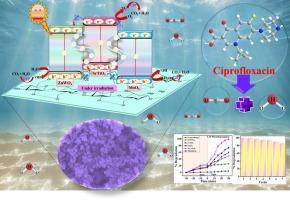Nanocellulose supported ZnWO4/SrTiO3/MoO3 heterojunction: Highly efficient visible light photocatalyst for ciprofloxacin degradation
IF 13.2
1区 工程技术
Q1 ENGINEERING, CHEMICAL
引用次数: 0
Abstract
The rationally designed step scheme (S-scheme) heterojunction has advanced to improve the charge separation and provide a high redox potential. Therefore, in the present work, we have synthesized the nanocellulose-based ZnWO4/SrTiO3/MoO3 (NC-ZSM) heterojunction using the ultrasonic-assisted wet impregnation method. Various microscopic and spectroscopic techniques like FE-SEM, HR-TEM, BET, XRD, FTIR, and XPS are used to study the heterojunction composition, structure, surface area, and charge carrier dynamics. BET study shows the high surface area of NC-ZSM (108.6 m2/g) with a large pore volume of 0.95 cm3/g, indicating many active sites. The XPS study confirms the charge migration pathway through S-scheme which is further supported by the trapping experiment. Furthermore, the UV–Vis, PL, and EIS studies revealed increased light absorption and charge separation in NC-ZSM heterojunction. The photodegradation experiment was conducted to evaluate the photoactivity against ciprofloxacin (CIP), a wide and common pharmaceutical pollutant. Here, NC-ZSM heterojunction degraded around 99.2 % of CIP under visible light irradiation within 30 min. To optimize the photoefficiency, photodegradation experiments were conducted at different reaction conditions. Maximum efficiency was achieved at 15 mg/L of photocatalytic dosage that degraded 40 mg/L CIP at pH = 6. Additionally, NC-ZSM showed high stability and retained around 85 % photocatalytic efficiency after performing seven catalytic cycles. Therefore, this work provides a powerful NC-ZSM S-scheme-based heterojunction that can generate hydroxyl and superoxide radical species, established by EPR and trapping experiments, capable of degrading a range of pharmaceutical pollutants.

纳米纤维素负载的ZnWO4/SrTiO3/MoO3异质结:环丙沙星降解的高效可见光催化剂
合理设计的阶梯结构(S-scheme)异质结改善了电荷分离并提供了高氧化还原电位。因此,本文采用超声辅助湿浸渍法合成了纳米纤维素基ZnWO4/SrTiO3/MoO3 (NC-ZSM)异质结。利用FE-SEM、HR-TEM、BET、XRD、FTIR和XPS等显微和光谱技术研究了异质结的组成、结构、表面积和载流子动力学。BET研究表明,NC-ZSM的比表面积大(108.6 m2/g),孔隙体积大(0.95 cm3/g),表明活性位点多。XPS研究证实了电荷通过S-scheme迁移的途径,并得到了俘获实验的进一步支持。此外,UV-Vis, PL和EIS研究显示NC-ZSM异质结的光吸收和电荷分离增加。通过光降解实验考察了其对环丙沙星(CIP)的光降解活性。在30 min的可见光照射下,NC-ZSM异质结降解了约99.2% %的CIP。为了优化光效,在不同的反应条件下进行了光降解实验。在pH = 6的条件下,光催化用量为15 mg/L时效率最高,降解40 mg/L的CIP。此外,NC-ZSM表现出很高的稳定性,在进行7次催化循环后,其光催化效率保持在85% %左右。因此,这项工作提供了一个强大的基于NC-ZSM s -scheme的异质结,可以产生羟基和超氧化物自由基,通过EPR和捕获实验建立,能够降解一系列药物污染物。
本文章由计算机程序翻译,如有差异,请以英文原文为准。
求助全文
约1分钟内获得全文
求助全文
来源期刊

Chemical Engineering Journal
工程技术-工程:化工
CiteScore
21.70
自引率
9.30%
发文量
6781
审稿时长
2.4 months
期刊介绍:
The Chemical Engineering Journal is an international research journal that invites contributions of original and novel fundamental research. It aims to provide an international platform for presenting original fundamental research, interpretative reviews, and discussions on new developments in chemical engineering. The journal welcomes papers that describe novel theory and its practical application, as well as those that demonstrate the transfer of techniques from other disciplines. It also welcomes reports on carefully conducted experimental work that is soundly interpreted. The main focus of the journal is on original and rigorous research results that have broad significance. The Catalysis section within the Chemical Engineering Journal focuses specifically on Experimental and Theoretical studies in the fields of heterogeneous catalysis, molecular catalysis, and biocatalysis. These studies have industrial impact on various sectors such as chemicals, energy, materials, foods, healthcare, and environmental protection.
 求助内容:
求助内容: 应助结果提醒方式:
应助结果提醒方式:


